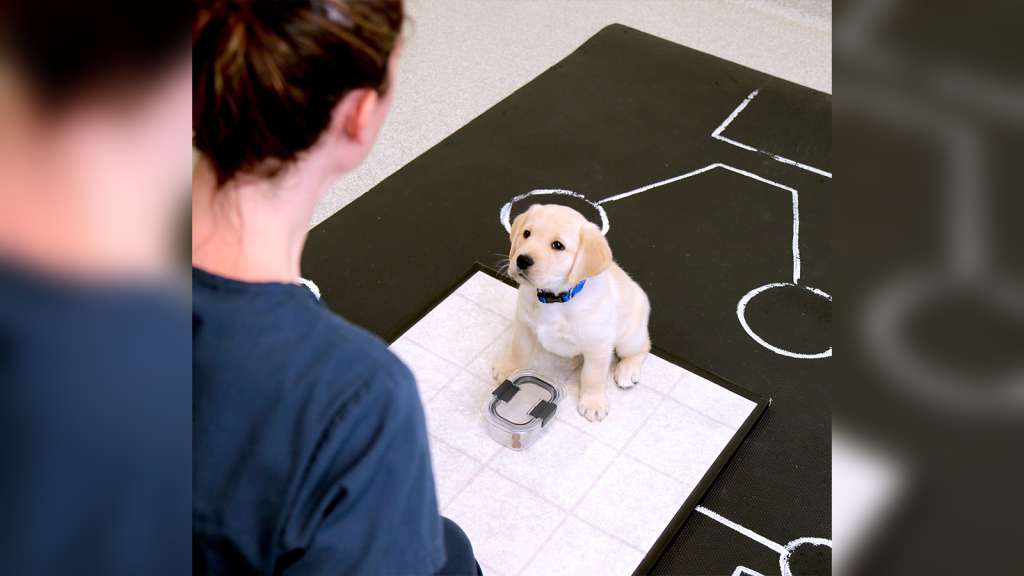(CNN) — What’s your favorite thing about puppies? Is it their cute yawns, wiggly bottoms or the sweet way they lick your nose? Or maybe it’s those doleful eyes that stare into yours as if they know what you are thinking.
Whatever it is, rest assured that puppies are primed to communicate with you soon after their birth, says Emily Bray, a post-doctoral research associate at the Arizona Canine Cognition Center at the University of Arizona’s School of Anthropology.
“Puppies will look at and return a person’s social gaze and successfully use information given by that person in a social context from a very young age, all prior to any extensive experience with people,” Bray said.
Bray has been studying guide dog development for the last decade in collaboration with Canine Companions, a nonprofit organization that provides dogs at no charge to adults, children and veterans with physical or cognitive disabilities.
The pool of service dogs is an excellent one for research because they often have known pedigrees going back multiple generations and are raised and trained in very similar ways. That gives researchers more options to determine how much of a dog’sbehavior is due to genetics versus environment or training.
A lot of puppies
In a study published Thursday in the journal Current Biology, Bray and her team evaluated 375 puppies that were all about 8 weeks old on a battery of social-cognitive measures that had already been given to adult dogs.
One task was eye contact with the researcher, another was to follow the researcher’s hand and eye gesture toward a treat hidden under one of two cups about 4 feet (1.3 meters) apart. Researchers hid the treats equally between the left and right cups.
“We know that adult dogs are good at these tasks,” Bray said. “When does that start? Does it take years of observing humans and living with humans, or is that ability something they are more biologically prepared for that has evolved over the course of domestication?”
All of the 375 puppies were Labrador retrievers, golden retrievers or a lab-golden mix and were still living with their mother and litter mates. None had left to live with volunteer trainers, where extensive one-on-one human interaction would begin.
Puppies were “highly skillful” at following the person’s cues of pointing and looking at just one of the cups where the treat was hidden, Bray said, and there was “no evidence that their performance required learning to do so.”
“Most of the puppies chose the right cup 70% of the time,” she said. “They’re not perfect, but it’s definitely better than chance. There’s something that they’re picking up on, even at 8 weeks old.”
In fact, many of the puppies were able to follow a person’s gesture or glance toward a hidden treat from the very first trial, with no training.
More than 40% of the variation in a puppy’s ability to follow a human’s finger point or gaze could be explained by the genes they’ve inherited, Bray said.
“It is an equation that we can calculate because we know the performance on the behavior, and we know how related all the puppies are to each other, because we have their pedigrees,” she said. “This is the first direct evidence to show there is a genetic basis.”
Baby talk a must
Why did the puppies engage in the first place? Researchers got the puppy’s attention with a high-pitched voice — what human moms would call “baby talk.”
Officially called “parentese,” the human version uses real words and correct grammar, but delivered at a higher pitch, a slower tempo and an exaggerated intonation, often mixed with silly sounds and words: “Oooh, your shozie wozies on your widdle feets.”
Studies have found such intonations are key to boosting a human baby’s speech and language development. In addition, babies have an innate preference for such talk.
It turns out puppies and dogs do as well. Called “dog-directed speech” in the canine research world, studies show dogs are most likely to respond well to high-pitched voices.
And they’ve trained their human owners well — it’s quite common to hear people speaking to their dogs in a sing-song, baby-like cadence: “Who’s a good boy? Are you a good boooy? Would you like a treat?”
Environment plays a role later
Not all of the puppies were equally responsive, Bray said: “Some puppies are locked in on you with their eyes, others are asleep in the corner, like I don’t care.”
But the team followed 160 of the puppies to adulthood and tested them on the same tasks again to seewhethertheir behavior as a puppy predicted how they would act as an adult.
“Almost universally across all of the tasks, performance improved as they aged, especially in things like impulse control and social cues,” she said. “They can do it when they’re young, but they can do it even better by the time they are an adult.”
One outcome of the research, Bray said, is that it will give more clues on the traits of a dog that eventually goes on to become a successful working dog, which could make the selection and training process more effective and efficient.
“For example, how willing the puppy is to to make and maintain eye contact is predictive of growing up to become a successful service dog,” she said.
Future research will be focused on trying to find which genes are attached to which traits, so that process can be even further refined, Bray said, along with which genes might be associated with cognitive decline as dogs age.
“There’s lots of work to be done with puppies,” Bray said with a chuckle. “It’s a tough job, but someone has to do it.”
The-CNN-Wire
™ & © 2021 Cable News Network, Inc., a WarnerMedia Company. All rights reserved.

